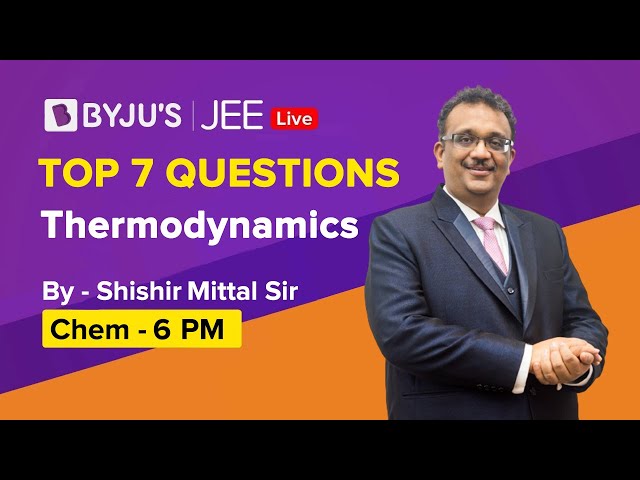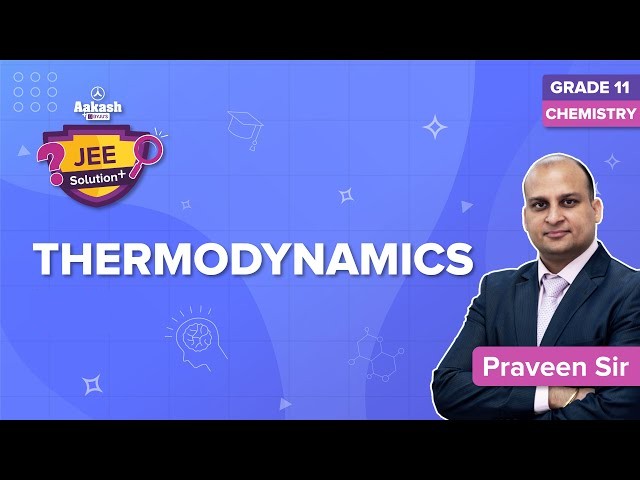Thermodynamics and Thermochemistry JEE Advanced Questions with Solutions are available here. We have compiled some of the most important questions on Thermodynamics and Thermochemistry from the past JEE Advanced exams. Therefore, going through the questions and solutions will help JEE aspirants in realizing the question types, patterns and difficulty levels. At the same time, practising solving the questions from this chapter will help them gain better concept clarity as well as they will have enough practice for the exam.
With Thermodynamics and Thermochemistry JEE Advanced Questions with Solutions aspirants will be able to study productively and perform better in the exam. Additionally, the JEE Advanced Thermodynamics and Thermochemistry questions with solutions are available in the form of a PDF which can be downloaded instantly. Students can use it to practice solving questions offline.
Download Thermodynamics and Thermochemistry Previous Year Solved Questions PDF
JEE Advanced Previous Year Questions on Thermodynamics and Thermochemistry
Question 1. One mole of an ideal gas at 300 K in thermal contact with surroundings expands isothermally from 1.0 L to 2.0 L against a constant pressure of 3.0 atm. In this process, the change in entropy of surroundings (∆Ssurr) in JK-1 is (1 L atm = 101.3 J)
A. 5.763
B. 1.013
C. -1.013
D. -5.763
Solution: (C)
Since it is an isothermal process, ΔU = 0
dq = −dW = Pext (V2 − V1) = 3L − atm = 3 × 101.3 J
ΔSsurrounding− 3 × 101.3 / 300 J K−1 = −1.013 J K−1
∴ ΔSsurr = −1.013 J K−1
Question 2. Tin is obtained from cassiterite by reduction with coke. Use the data given below to determine the minimum temperature (in K) at which the reduction of cassiterite by coke would take place.
At 298 K: ∆ 0(SnO2(s)) = −581.0 kJ mol−1, ∆ 0(CO2(g)) = −394.0 kJ mol−1,
0(SnO2(s)) = 56.0J K−1mol−1, So(Sn(s)) = 52.0 J K−1mol−1,
0(C(s)) = 6.0J K−1mol−1, 0(CO2(g)) = 210.0 J K−1mol−1.
Assume that the enthalpies and the entropies are temperature independent.
Solution: (935)
SnO2(s) + C(s) → CO2 + Sn
∆H = (∆f H)P – (∆f H)R
= – 394 + 581 = +187 KJ/mol-1
∆S = (∆S)P – (∆S)R
= 210 + 52 – 56 – 6
= 200 J/k mol
∆G = 187 × 1000 – 200 × T
T = [187 × 1000] / 200 = 935 K
Question 3. In thermodynamics the P-V work done is given by w = −∫dVPext
For a system undergoing a particular process, the work done is, w = −∫dV(RT / V − b − a / V2)
This equation is applicable to a;
A. System that satisfies the van der Waals equation of state
B. Process that is reversible and isothermal
C. Process that is reversible and adiabatic
D. Process that is irreversible and at constant isothermal
Solution: (A, B and C)
w = −∫PextdV
From van der Waal equation of state for one-mole gas.
(P + a / V2 (v – b) = RT P = RT / V – b – a / V2
For reversible process
Pext. = Pgas
W = −∫(RT/ V – b) – (a / v2)dv
So, the process is not applicable only for irreversible processes.
Hence, the correct options are a, b, c
Question 4. A reversible cyclic process for an ideal gas is shown below. Here, P, V and T are pressure, volume and temperature, respectively. The thermodynamic parameters q, w, H and U are heat, work, enthalpy and internal energy, respectively.

The correct option(s) is (are)
A. qAC = ΔUBC and wAB = P2(V2 – V1)
B. wBC = P2(V2 – V1) and qBC = ΔHAC
C. ΔHCA < ΔUCA and qAC = ΔUBC
D. qBC = ΔHAC and ΔHCA > ΔUCA
Solution: (B and C)
AC → Isochoric
AB → Isothermal
BC → Isobaric
# qAC = ΔUBC = nCV (T2 – T1)
WAB = nRT1 ln (V2/V1) A (wrong)
# qBC = ΔHAC = nCP (T2 – T1)
WBC = – P2(V1 – V2) B (correct)
# nCP (T1 – T2) < nCV(T1 – T2) C (correct)
ΔHCA < ΔUCA
# D (wrong)
Question 5. An ideal gas is expanded from (p1, V1, T1) to (p2, V2, T2)under different conditions. The correct statement(s) among the following is/are:
A. The work done on the gas is maximum when it is compressed irreversibly from (p2, V2) to (p1, V1) against constant pressure p1
B. The work done by the gas is less when it is expanded reversibly from V1 to V2 under adiabatic conditions as compared to that when expanded reversibly from V1 to V2 under isothermal conditions
C. If the expansion is carried out freely, it is simultaneously both isothermal as well as adiabatic
D. The change in internal energy of the gas is (i) zero if it is expanded reversibly with T1 = T2, and (ii) positive, if it is expanded reversibly under adiabatic conditions with T1 ≠ T2
Solution: (A, B and C)
(A) ω = −Pext ΔV
Work done on gas when compressed
ω = is positive
∴ equation becomes ω = Pext ΔV
(B) under adiabatic conditions
ω = (P2V2 − P1V1) / (γ − 1)
since equation V2 > V1
∴ ω = +ve (work done on the system)
for reversible condition (Isothermal)
ω = −nRTln V2 / V1
= V2 > V1
ω = −ve (work done on the system)
ω = −ve (for adiabatic reversibly work done by gas)
ω = +ve (for isothermal reversibly work done by gas)
(C) As free expansion in there (irreversible)
∴Pext=0
ω = (−Pext × ΔV) = 0 (Isothermal irreversible process)
In adiabatic ΔU = −ve
ΔU = q + ω
− = 0 + ω
ω = −negative
similarly, ΔG = ΔH − TΔs
gas expand ∴ Δs = +ve
ΔG = ΔH − Ve
= ΔV + pΔV − ve
= q + w + pΔc − ve
= o + w + w − ve
= −ve + (−ve) − ve
ΔG = −ve
∴ The process is spontaneous
∴ both occur simultaneously
Question 6. An ideal gas in a thermally insulated vessel at internal pressure = P1, volume = V1 and absolute temperature = T1 expands irreversibly against zero external pressure, as shown in the diagram. The final internal pressure, volume and absolute temperature of the gas are P2, V2 and T2, respectively. For this expansion,

A. q = 0
B. T2 = T1
C. P2 V2 = P1 V1
D. P2 V1γ = P1V1γ
Solution: (C)
Since the container is thermally insulated q = 0, and it is a case of free expansion therefore W = 0 and ∆ = E 0
So, T1 = T2
Also, P1V1 = P2V2
Question 7 and 8 Paragraph: A fixed mass ‘m’ of gas is subjected to the transformation of the state from K to L to M and back to K as shown in the figure.

Question 7. The succeeding operations that enable this transformation of state are;
A. Heating, cooling, heating, cooling
B. Cooling, heating, cooling, heating
C. Heating, cooling, cooling, heating
D. Cooling, heating, heating, cooling
Solution: (C)
To reiterate the operations follow the path K, L. M, N. We simply need to use the ideal gas law here to get an idea of what happens. The ideal gas law states that:
PV = nRT
Since there is only a transformation of states number of moles (n) remains constant. Looking at these processes, in each of the steps either the pressure of the volume is constant. So using this law it is pretty easy to figure out what happens.
Clearly – K to L would be heating since volume is increasing (P is constant). L to M is interesting since P decreases keeping V constant. Now, this is possible only if cooling happens (i.e. T falls). This is a direct consequence of the ideal gas law.
Similarly, in steps M – N cooling happens : P is constant, V decreases which mean that T must fall. And lastly, N – K heating has to happen since V is constant, and P increases.
The process taking place at:
Constant temperature – isothermal
Constant pressure – isobaric
Constant volume – isochoric
Constant heat – adiabatic

Question 8. The pair of isochoric processes among the transformation of states is
A. K to L and L to M
B. L to M and N to K
C. L to M and M to N
D. M to N and N to K
Solution: (B)
Here you just need to know that isochoric means a constant volume process. Since V is on the X-axis, any process which is represented by a line perpendicular to the X-axis would be an isochoric one.

K-L heating, isobaric
L-M cooling, isochoric
M-N cooling, isobaric
N-K heating, isochoric
Question 9. The standard state Gibbs free energies of formation of C(graphite) and C(diamond) at T = 298 K are ΔfG∘C(graphite) = 0 kJ mol−1
ΔfG∘C(diamond) = 2.9 kJ mol−1
The standard state means that the pressure should be 1 bar, and the substance should be pure at a given temperature. The conversion of graphite C(graphite) to diamond C(diamond) reduces its volume by 2 × 10−6m3mol−1. If C(graphite) is converted to C(diamond) isothermally at T = 298 K, the pressure at which C(graphite) is in equilibrium with C(diamond), is?
[Useful information: 1 J = 1 kgm2s−2; 1 Pa = 1 kg m−1s−2; 1 bar = 105 Pa]
A. 14501 bar
B. 29001 bar
C. 1450 bar
D. 58001 bar
Solution: (A)
Cgraphite → Cdiamand
ΔGro = ΔGdiamondo − ΔGgraphiteo
2.9 KJmol−1 − 0 KJmol−1 = 2.9 KJmol−1
ΔGro = ΔHro −TΔSro
ΔSro ≈ 0
TΔSro ≈ 0
ΔHro = ΔEro + Δ(PV)
Δro= 0 because of isothermal process ΔT = 0
ΔHro = 2.9 × 103 = Δ(PV)
At equilibrium pressure is constant
2.9 × 103 Jmol−1 = P(V2 − V1)
P = 2.9 × 103 Jmol−1 / 2 × 10−6 m3 mol−1
= 1450 × 106 pascal
= 14500 bar
Total pressure = equilibrium pressure + initial pressure = 14501bar
Hence, the correct option is A.
Question 10. For the process –
H2O(l) → H2O(g) at T = 100°C and 1 atmosphere,
The correct choice is:
(A) ∆Ssystem > 0 and ∆Ssurrounding > 0
(B) ∆Ssystem > 0 and ∆Ssurrounding < 0
(C) ∆Ssystem < 0 and ∆Ssurrounding > 0
(D) ∆Ssystem < 0 and ∆Ssurrounding < 0
Solution: (b)
At 100∘C and 1-atmosphere pressure H2O(l) ⇌ H2O(g) is at equilibrium.
For equilibrium,
ΔStotal = 0 and ΔSsystem + ΔSsurrounding = 0
∴ΔSsystem>0 and ΔSsurrounding<0
Hence, the correct option is B.
Thermodynamics Important Topics

Thermodynamics Important Questions

Thermodynamics Top 7 Questions

Thermodynamics JEE Solutions

Comments